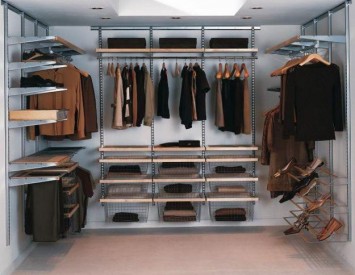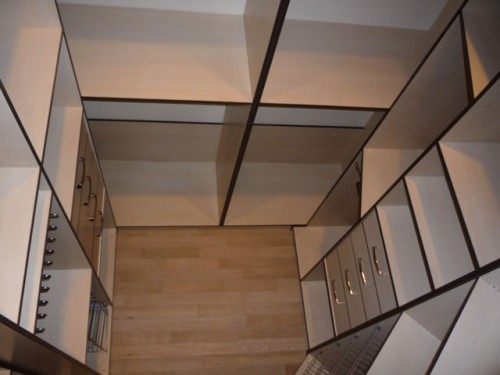The problem of free space and ordered space exists in every house. The dressing room is a dream of every woman and it is possible to realize it even in a small apartment. It is not difficult to make a wardrobe wardrobe with your own hands, this will require a little imagination and skillful hands. A positive moment in the construction of the wardrobe is the disposal of the old boring furniture and the appearance of free space in the apartment.
Content
Materials for dressing rooms are used by the most diverse. It is required to build a partition in a suitable place for this, install the door and shelves for things. When making a wardrobe with your own hands, you should think over the design and location so that it naturally fits into the overall interior of the room.
Choosing a place and marking for a wardrobe cabinet
Carefully inspect and measure likely places for arranging a wardrobe cabinet in the apartment. Pay attention to the pantry, the dead end of the corridor, corner spaces in large rooms, etc. In the diagram, mark the places for shelves and racks for things, the design should provide convenient access to stored clothes.
- Sketch the approximate drawing on paper and decide on the materials. For dressing rooms, drywall, chipboard, plastic lining wall panels MDF, OSB or other suitable materials can be suitable.
- On the walls, make a vertical marking of the future scraping of the dressing room, checked with a plumb line or a waterpasis. Connect the lines on the floor and ceiling. The doors have an important function, they can be made standard or sliding.
Arrangement of a wardrobe cabinet in a dead end space of the corridor
The dead end space of the corridor is ideal for the arrangement of the dressing room. You already have three finished walls and ceiling. It remains to make a facade bed and door. Materials for the pie are most diverse. It is even better if you redid the pantry for the dressing room.
- Mark the walls, ceiling and floor for installation of a pie. The frame is made of a beam with a cross section of at least 4x4 cm, and a special profile is used for drywall. The doorway, make at the rate of 90 cm in width and up to 2 meters in height. The rest of the area is sewn up with a square cell with a step from 75x75 cm to 1x1 meter.
- The opening for doors is cut in advance. In the upper part of the opening in the corners, small, with a diameter of 8 - 10 mm of the hole, are drilled. Longitudinal and transverse cuts can be made with an electric jigsaw. The sheets carved for the doorway can be used to make doors. The door to the wardrobe is a dressing room, you can make glazed, sliding. Thus, a place is saved and an additional light source arises.
- A sheet of chipboard or OSB has quite large sizes of about 2800x2070 mm. Two such sheets, enough to block the opening completely, four - to close it on both sides. On chipboard or OSB, wallpaper is easily glued, drywall requires putty and painting.
- It is important to properly plan and install in the room shelves, racks and racks for the shoulders on which clothes are hung. Mobile cabinets and racks, much more convenient for cabinet furniture. Any correctly planned dressing room is divided into two parts. On the one hand, a bar for shoulders is attached, and on the other hand, shelves for things.
Arrangement of a dressing room of a dressing room in a room
A straight wardrobe in the dressing room in the room is somewhat more difficult to make. It is best to place it in the corner, then you will have two stationary rear walls. The design attached to them will be much more stable and stronger.
- If the apartment does not have a suitable corner for arranging a built -in cabinet with your own hands, you can make a direct cabinet in the room. To do this, mount the frame - the base of the dressing room and fix it with screws to the floor and wall. The function of the back wall will be performed by the wall itself. The side walls of the wardrobe wardrobe can be made from chipboard. This will solve the issue of finishing work.
- The facade side - can be made with sliding doors. Buy accessories and mounts in a furniture store. These are two guides, the upper and lower, the rollers attached directly on the canvas of doors, pens and stoppers. The door leafs themselves can be decorated with mirrors. Sliding doors of such a cabinet compartment open full access to things placed in it.
Arrangement of a corner of drywall
A properly equipped angular wardrobe will save space and order the space. Gypsum cardboard, light and convenient processing material. It is not difficult to build such a closet with your own hands, and the material costs are minimal.
- A good solution would be the arrangement of a corner cabinet with your own hands. To do this, you need to build one facade wall and equip the entrance. To arrange a facade partition made of drywall, you will need two types of profiles. Strike, it is used for vertical racks and has dimensions - 50x50, 50x65. And the guide, you will need it for the installation of the doorway and jumpers. A suitable profile is 50x40 or 65x40.
- The standard size of the wall plasterboard is 2.5 per 1.2 meters. For facade wall plasterboard, preferred thickness is 12.5 mm. Subtle dimensions are used for ceilings. Gypsum plasterboard is easily cut by a drywall with a knife and mounted with self -tapping screws to the frame from the profile.
- After marking is made, guide profiles are fixed on the floor, ceiling and walls. One meter of profile, three dowels are used. Vertical rack profiles are attached to them, and a checkered base is made from guide profiles, with the size of the side of 65-75 cm. To strengthen the doorway, you can have a wooden beam in the profile.
- To begin with, install and fix entire sheets that do not require fitting. Flow from the corner, with self -tapping screws with a step of 250 mm. The heads of the screws “drive” by 1 - 2 mm. Starting putty, plow the joints of drywall sheets and screwing the screws.
- Corner joints and adjacents to the wall are sealed with a plastic corner profile or a reinforced glass -fiber mesh. The layout of the corner cabinet is puttled with the finish putty, grinds and paints. If desired, you can glue the wallpaper.













